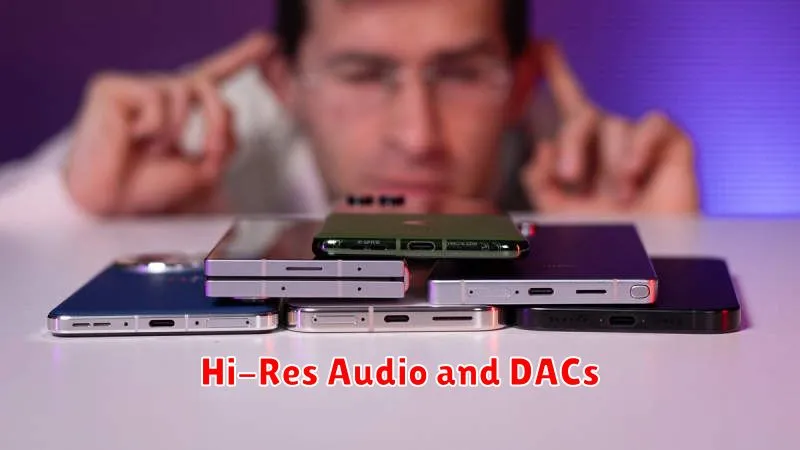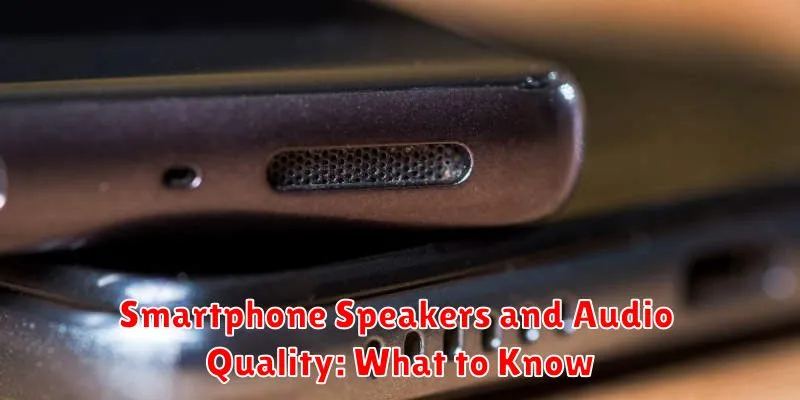In today’s world, smartphones have become indispensable tools, serving as more than just communication devices. They are our cameras, our navigation systems, and, importantly, our portable entertainment centers. For many, a smartphone is their primary means of consuming audio content, from music and podcasts to audiobooks and videos. Therefore, understanding smartphone speakers and audio quality is crucial for maximizing your listening experience. This article delves into the essential aspects of smartphone audio, exploring key factors that influence sound quality and providing valuable insights to help you choose a device that meets your auditory needs.
This comprehensive guide will cover various topics related to smartphone speakers and audio quality. We will discuss the different types of speaker technologies employed in modern smartphones, such as stereo speakers, mono speakers, and even the resurgence of the headphone jack. Additionally, we will explore important audio specifications, including frequency response, dynamic range, and total harmonic distortion, explaining how these parameters contribute to overall sound quality. By the end of this article, you will be well-equipped to make informed decisions regarding your next smartphone purchase, ensuring an optimal audio experience tailored to your preferences.
Types of Smartphone Speakers
Smartphones typically employ a few different types of speakers to deliver audio output. The most common is the earpiece, a small speaker located at the top of the phone used primarily for phone calls.
The main speaker, also known as the loudspeaker, is responsible for producing louder audio for media playback, ringtones, and speakerphone calls. Some devices use a single speaker for both purposes, while others have dedicated components.
Increasingly common in modern smartphones are stereo speakers, typically a combination of the main speaker and a secondary speaker, often the earpiece, working in tandem to provide a wider soundstage.
Mono vs Stereo Audio
Understanding the difference between mono and stereo audio is crucial when evaluating smartphone speakers. Mono audio uses a single channel, meaning all sounds are mixed together and output through one speaker or both speakers playing the identical audio. This results in a flatter, less immersive soundstage.
Stereo audio, on the other hand, utilizes two channels, separating sounds and delivering them through two distinct speakers (left and right). This creates a sense of depth and spaciousness, making the audio experience richer and more engaging. Stereo sound provides a more accurate representation of how we perceive sounds in the real world.
Speaker Placement and Design
Speaker placement significantly impacts the audio experience. Many smartphones utilize a combination of a bottom-firing main speaker and a smaller, front-facing speaker often integrated into the earpiece. This setup aims to create a stereo effect.
Design choices also influence audio output. The size and shape of the speaker chamber, the materials used, and the speaker’s diaphragm all affect sound quality. Smaller speakers and limited chamber space often result in less powerful bass response.
Some manufacturers employ specialized audio tuning and software enhancements to optimize sound output despite physical limitations.
Hi-Res Audio and DACs

Hi-res audio refers to audio files with higher sampling rates and bit depths than standard CD quality (16-bit/44.1kHz). This theoretically results in a more accurate and detailed sound reproduction.
To process these high-resolution files, a digital-to-analog converter (DAC) is required. DACs are responsible for converting the digital audio signal into an analog signal that your headphones or speakers can output. Smartphones often have built-in DACs, but their quality can vary significantly.
Some smartphones boast dedicated, high-quality DACs capable of handling hi-res audio playback. These devices aim to provide an enhanced listening experience for audiophiles who prioritize superior sound quality. However, the perceived benefits of hi-res audio and dedicated DACs are often debated, with factors like headphone quality and individual hearing capabilities playing a significant role.
External Audio Accessories
While smartphone speakers have improved, external audio accessories offer enhanced sound quality and versatility. Headphones remain a popular choice, ranging from basic earbuds to noise-canceling over-ear models. For a shared listening experience, Bluetooth speakers provide portability and decent audio output.
DACs (Digital-to-Analog Converters) and amplifiers cater to audiophiles seeking higher fidelity sound. These devices bypass the phone’s internal audio processing, delivering superior audio resolution and power output.
Audio Profiles and Equalizers
Many smartphones offer pre-configured audio profiles tailored for different listening scenarios, such as music, movies, or podcasts. These profiles adjust the audio output to optimize the listening experience for the selected content type. They can significantly impact the perceived sound quality.
Beyond pre-set profiles, some devices provide a customizable equalizer. An equalizer gives users more granular control over the audio frequency spectrum, allowing them to adjust bass, mid-range, and treble levels to their liking. This feature helps personalize the sound output and compensate for weaknesses in the speakers or headphones being used.
Sound Quality in Voice Calls
Clarity and volume are paramount for a positive voice call experience. A quality smartphone prioritizes noise cancellation, minimizing background distractions for both the speaker and listener. This ensures conversations are clear and easy to understand even in noisy environments.
The earpiece plays a vital role, delivering clear audio directly to the user’s ear. Its positioning and design significantly impact the overall call quality. Likewise, a good microphone accurately captures the speaker’s voice, transmitting it clearly to the recipient.
Dolby Atmos and Sound Enhancements
Many modern smartphones boast audio enhancements like Dolby Atmos, DTS:X, and other proprietary technologies. These aim to create a more immersive listening experience by virtualizing surround sound and enhancing bass and clarity. Dolby Atmos, in particular, is prevalent and often a key selling point.
These technologies work by processing the audio signal to create a sense of spaciousness and depth, even from the phone’s small speakers. The effectiveness of these enhancements can vary depending on the phone’s hardware and the quality of the audio source. While they can’t replicate a true surround sound system, they can offer a noticeable improvement over standard stereo sound.
Gaming and Media Audio Experience
Smartphone speakers play a crucial role in enhancing the gaming and media consumption experience. Audio quality significantly impacts immersion and enjoyment, whether you’re playing a graphically intensive game or watching a movie.
Features like stereo speakers and spatial audio technologies contribute to a more immersive soundscape. Stereo speakers provide a wider soundstage, creating a more realistic sense of directionality. Spatial audio further enhances this by creating a 3D audio environment, placing sounds around the listener for a more engaging experience.
When evaluating smartphone audio for gaming and media, consider factors such as loudness, clarity, and bass response. A balance of these factors ensures clear dialogue, impactful sound effects, and an overall enjoyable listening experience.
Top Phones with Great Speakers

Several smartphones prioritize audio quality, offering excellent built-in speakers for a richer media experience. When choosing a phone for its audio capabilities, consider factors like stereo speakers, loudness, and clarity.
Some current models renowned for their superior speakers include:
- Phone A: Known for its balanced audio and impressive bass.
- Phone B: Features loud, clear sound with a wide soundstage.
- Phone C: Offers excellent dynamic range and minimal distortion.
It’s important to note that speaker performance can be subjective. Reading reviews and comparing specs can help you determine which phone best suits your audio needs.

